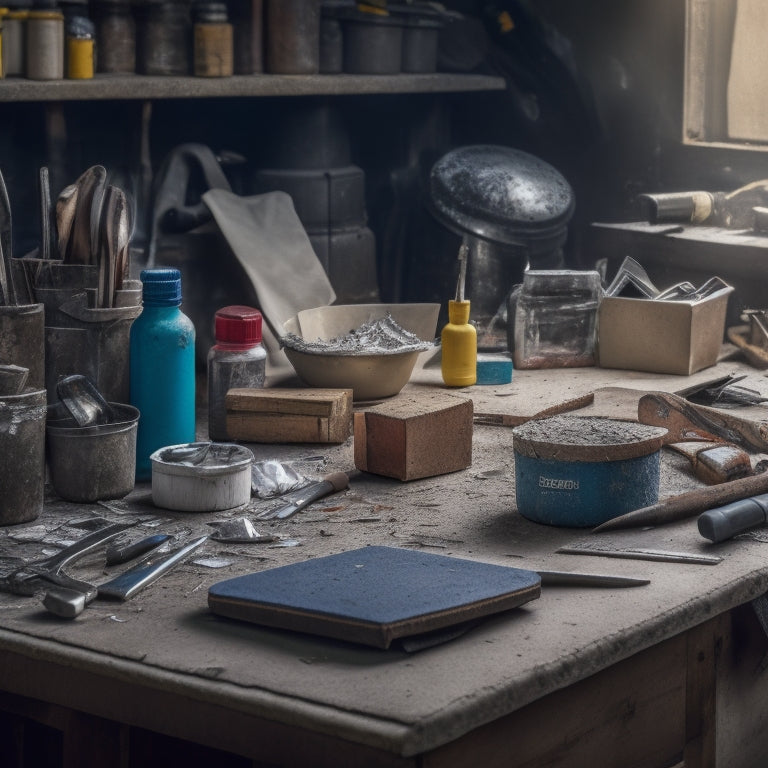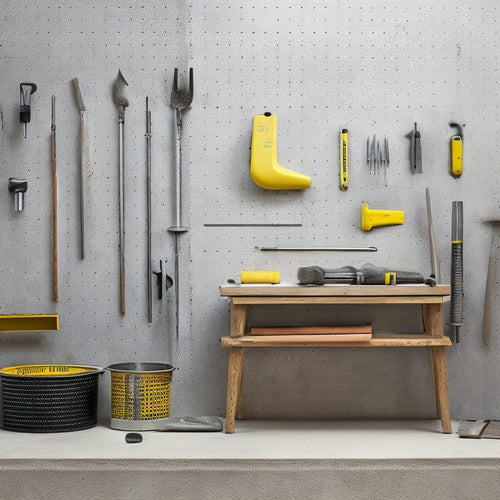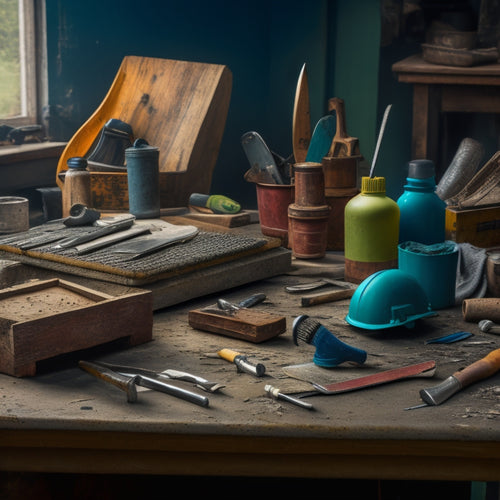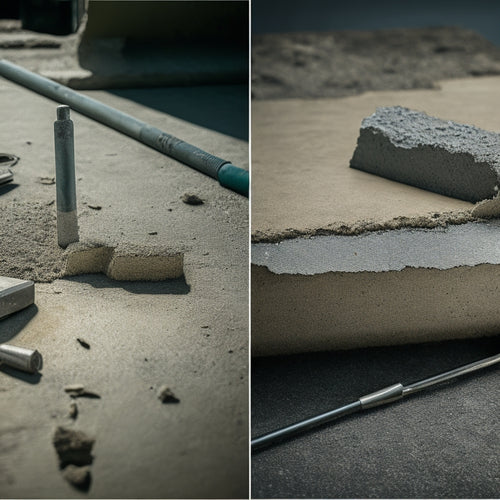
10 Must-Have Tools for Filling Concrete Gaps
Share
You'll need a range of essential tools to fill concrete gaps successfully, from safety gear like gloves, goggles, and knee pads to measuring and marking tools, such as tape measures and high-visibility markers. Cleaning and preparing surfaces requires wire brushes, scrapers, and solvents, while mixing and applying materials demands careful selection of materials and proper mixing techniques. Filling and compacting tools, like tampers and compactors, guarantee even distribution, and curing and sealing agents protect the new concrete. To get it right, you'll also need chiseling and scraping tools, bonding and reinforcing materials, and finishing and smoothening tools - and that's just the beginning of creating a strong, long-lasting bond.
Key Takeaways
• Safety gear like gloves, goggles, and dust masks are essential for protecting yourself from chemical splashes and flying particles.
• A reliable tape measure with high accuracy (±1/16 inch or better) is crucial for precise gap measurements and marking.
• Cleaning and preparing surfaces with wire brushes, scrapers, and solvents ensures a strong bond between old and new concrete.
• Filling and compacting tools like tamping tools, chisels, and compacting rods are necessary for eliminating air pockets and achieving even distribution.
• Curing and sealing agents like membrane-forming curing compounds and topical sealers provide long-term protection and durability to the repaired concrete.
Safety Gear and Protective Equipment
Wearing the right safety gear and protective equipment is essential when filling concrete gaps, as it shields you from harsh chemicals, flying debris, and other hazards.
You'll want to prioritize protective gloves to prevent skin irritation and abrasions. Safety goggles will protect your eyes from chemical splashes and flying particles. Don't forget dust masks to filter out airborne contaminants and prevent respiratory issues.
Knee pads will save your joints from the constant kneeling and bending. Hearing protection, such as earplugs or earmuffs, will safeguard your hearing from loud machinery and tools. A hard hat will protect your head from falling objects or debris.
Safety vests with reflective strips will increase visibility, especially in low-light conditions. Finally, slip-resistant footwear will prevent slips and falls on wet or oily surfaces.
Measuring and Marking Tools
When you're filling concrete gaps, getting the measurements right is essential.
You'll need a reliable tape measure that can withstand the demands of the job site, so don't skimp on quality.
Tape Measures Matter
Measuring gaps accurately sets the stage for a successful concrete repair, and you'll rely on a trusty tape measure to get it right.
When it comes to tape measure accuracy, you want a tool that provides precise readings. Look for a tape measure with a high level of accuracy, typically ±1/16 inch or better.
You'll also need to take into account the type of tape measure that suits your needs. There are three main types: fiberglass, steel, and hybrid. Fiberglass tapes are lightweight and flexible, making them ideal for tight spaces. Steel tapes are more durable and resistant to wear and tear. Hybrid tapes offer a balance between flexibility and durability.
When choosing a tape measure, think about the length you need. Common lengths range from 12 to 33 feet. You may also want to take into account additional features like a fractional readout, which makes it easier to take precise measurements.
A good tape measure is an essential tool for any concrete repair project. By selecting the right one, you'll guarantee accurate measurements and set yourself up for success.
Accurate Marking Essential
With your gap dimensions in hand, you'll need to accurately mark the area where the concrete will be filled. Making a high-quality marking tool an essential part of your toolkit is crucial. This is where precision tools come into play, enabling you to execute marking techniques with confidence. A good marking tool guarantees that your fill material is applied accurately, resulting in a seamless finish.
When it comes to marking tools, you'll want to take into account the following essentials:
-
A high-visibility marker that stands out against the concrete surface
-
A precision chalk line reel that produces a crisp, accurate line
-
A sturdy, adjustable marker that can be set to precise angles
- A set of fine-tip markers for detailed, intricate work
Cleaning and Preparing Surfaces
Cleaning and Preparing Surfaces
Remove any debris, oil, or old adhesive from the concrete surface using a wire brush, scraper, or solvent to guarantee a strong bond between the old concrete and the new filler. This step is vital, as any residue left behind can compromise the integrity of the repair. Conduct a thorough surface assessment to identify areas that require extra attention. Look for cracks, unevenness, or signs of wear that may affect the filler's adhesion.
Next, focus on debris removal. Use a wire brush or scraper to dislodge loose particles, and then sweep or blow them away. If you're dealing with stubborn oil or adhesive stains, apply a solvent and let it sit for a few minutes before scrubbing and rinsing.
Make certain the surface is dry and free of any contaminants before moving forward. A well-prepared surface is essential for a successful repair, so take your time and do it right.
Mixing and Applying Materials
Now that you've prepared the surface, it's time to focus on mixing and applying the right materials to fill those concrete gaps.
You'll need to select the appropriate material for the job, considering factors like strength, durability, and aesthetics.
Material Selection Guide
When filling concrete gaps, selecting the right material is essential, as it directly impacts the durability and appearance of the repaired surface. You want a material that not only fills the gap but also guarantees a strong bond with the surrounding concrete.
To make the right choice, consider the following factors:
-
Material durability: Choose a material that can withstand the same environmental conditions as the surrounding concrete, such as exposure to water, sunlight, or extreme temperatures.
-
Cost considerations: Balance the cost of the material with its performance and durability. A cheap option mightn't be the best value in the long run if it needs to be reapplied frequently.
-
Color and texture: Select a material that matches the color and texture of the surrounding concrete for a seamless repair.
- Moisture tolerance: If the gap is in an area exposed to water, choose a material that can tolerate moisture without compromising its performance.
Proper Mixing Techniques
As you prepare to fill the concrete gap, make certain to mix the selected material according to the manufacturer's instructions to achieve the ideal consistency and strength. Proper mixing techniques are vital to guarantee a successful repair.
Start by following the recommended mixing ratios, which typically involve combining the material with water or another specified liquid. Use a mixing stick or trowel to blend the ingredients until you achieve a smooth, lump-free consistency.
It's essential to mix the material in a clean, dry container to prevent contamination. Avoid overmixing, as this can lead to a weakened bond between the old and new concrete. Instead, mix in small batches, and apply the material immediately to the gap.
Use a putty knife or trowel to fill the gap, pressing the material firmly into place. Finish by smoothing out the surface with a leveling tool or trowel.
Filling and Compacting Tools
You'll need a range of filling and compacting tools to guarantee a strong, durable bond between the old and new concrete. This is where the magic happens, and the gap assessment you did earlier pays off. When filling the gap, it's crucial to use the right tools to make sure the new concrete adheres properly to the old.
Here are some must-have tools for filling and compacting:
-
Tamping tools, such as hand tampers or plate compactors, to remove air pockets and make certain the new concrete is evenly distributed.
-
Chisels or scraper tools to remove any debris or old concrete from the gap.
-
A level or straightedge to make sure the new concrete is level with the surrounding surface.
- A compacting rod or screed board to compact the concrete and remove any excess material.
Curing and Sealing Agents
After compacting the new concrete, focus on applying curing and sealing agents to protect the filled gap from environmental stressors and guarantee a long-lasting repair.
You'll want to choose the right curing methods for your specific project, considering factors like temperature, humidity, and exposure to sunlight or water. Popular options include membrane-forming curing compounds, wax-based curing compounds, and evaporation retarders.
When it comes to sealing techniques, you'll need to decide between topical sealers, penetrating sealers, and integral sealers. Topical sealers provide a physical barrier against water and contaminants, while penetrating sealers absorb into the concrete to repel water and reduce staining. Integral sealers are mixed into the concrete itself, offering long-term protection and durability.
Regardless of the curing and sealing agents you choose, make certain to follow the manufacturer's instructions and take necessary safety precautions. By applying these agents correctly, you'll guarantee a strong, durable bond between the old and new concrete, and a successful repair that will last for years to come.
Crack Width and Depth Gauges
Measure the crack width and depth accurately with gauges, verifying you're filling the gap with the right amount of concrete and avoiding costly overfills or underfills. This step is essential in effective crack assessment techniques and gap evaluation methods. You can't afford to guess the dimensions of the crack, as it may lead to subpar repairs.
When choosing a crack width and depth gauge, consider the following key features:
-
Digital or analog display: Verify the gauge provides accurate and easy-to-read measurements.
-
Adjustable jaws: This feature allows you to measure cracks of varying widths.
-
Depth measurement capability: Look for gauges that can measure depth in addition to width.
- Durable construction: Your gauge should withstand the demands of the job site.
Chiseling and Scraping Tools
With accurate measurements in hand, it's time to prepare the crack for filling by removing loose debris and old filler material using chiseling and scraping tools.
You'll need a variety of chisel types to tackle different crack sizes and shapes. For example, a flat chisel is ideal for removing old filler material, while a pointed chisel is better suited for breaking up loose concrete. When choosing a chisel, consider the handle material, as fiberglass or steel handles can provide more leverage and control.
When it comes to scraping techniques, you'll want to use a gentle, sweeping motion to remove debris and old filler material. Be careful not to gouge the surrounding concrete, as this can create more damage. A wire brush or scraper can also be used to remove loose particles and dust.
Bonding and Reinforcing Materials
When filling concrete gaps, you'll need to guarantee a strong bond between the old and new concrete.
You'll have to choose the right bonding agent for your specific project, as different options offer varying levels of strength and durability.
Bonding Agent Options
You'll find that bonding agents, also known as bonding and reinforcing materials, play an essential role in guaranteeing a strong, durable bond between old and new concrete. When it comes to filling concrete gaps, the right bonding agent can make all the difference.
You have several options to choose from, including:
-
Epoxy adhesives, which provide a strong, flexible bond and are often used for structural repairs.
-
Acrylic-based bonding agents, which are ideal for non-structural repairs and offer excellent workability.
-
Polymer additives, which can be mixed with cement to create a strong, durable bond.
- Polyurethane-based bonding agents, which offer excellent flexibility and are often used for repairs in high-traffic areas.
When selecting a bonding agent, consider the specific requirements of your project, including the type of concrete, environmental conditions, and desired bond strength.
Stronger Concrete Bonds
Selecting the right bonding and reinforcing materials is essential to achieving stronger concrete bonds that can withstand various environmental conditions and heavy use. When you choose the right bonding agents, you're ensuring a strong, durable bond between old and new concrete. This is critical for filling gaps, as a weak bond can lead to further damage and deterioration.
To optimize adhesive performance, you'll want to focus on surface preparation. Make sure the area is clean, dry, and free of any debris or oils. Use a degreaser or pressure washer to remove any contaminants that could compromise the bond.
Next, apply a bonding agent specifically designed for concrete, following the manufacturer's instructions. This will help create a strong, chemical bond between the old and new concrete.
Reinforcement Materials Needed
Now that you've prepared the surface and applied a bonding agent, it's time to add reinforcement materials to confirm the filled gap can withstand structural stress and last for years to come. This vital step guarantees the concrete gap repair maintains its structural integrity and doesn't crack or crumble under pressure.
Effective reinforcement strategies require the right materials. You'll need:
-
Fiber mesh: Adds tensile strength and prevents shrinkage cracks
-
Rebar: Provides additional strength and stability to the filled gap
-
Steel fibers: Enhances durability and resistance to impact
- Polymer-modified fibers: Improves flexural strength and reduces the risk of delamination
Finishing and Smoothening Tools
Finishing and Smoothening Tools
To achieve a smooth, even finish, use trowels, floats, or finishing blades to remove excess concrete and flatten out the surface. These tools help you create the desired surface texture and improve the overall appearance of your concrete project. Mastering trowel techniques is vital to achieving a professional-looking finish.
Here's a breakdown of the different finishing and smoothening tools you'll need:
| Tool | Description |
|---|---|
| Trowel | Used for applying and smoothing out fresh concrete |
| Float | Helps to flatten and even out the surface |
| Finishing Blade | Removes excess concrete and leaves a smooth finish |
| Edger | Creates a clean, defined edge around the concrete surface |
| Broom | Adds texture to the surface for better traction |
Frequently Asked Questions
Can I Use a Polyurethane-Based Sealant on Freshly Poured Concrete?
You're wondering if you can use a polyurethane-based sealant on freshly poured concrete. The short answer is, it's possible, but not ideal.
Polyurethane sealants offer benefits like flexibility and durability, but they require a clean, dry surface to adhere properly.
Freshly poured concrete takes time to cure, and applying a sealant too soon can hinder the curing process.
Wait until the concrete has cured for at least 28 days before applying a polyurethane sealant to guarantee a strong bond.
How Do I Prevent Concrete From Sticking to My Tools and Equipment?
You've finally mixed and poured the perfect concrete, but now you're faced with a new challenge: how to prevent it from sticking to your tools and equipment.
The secret lies in proper tool maintenance and equipment cleaning. Before pouring, lightly mist your tools with a release agent or cooking spray.
After use, clean them thoroughly with soap and water, and dry them to prevent rust.
Are There Any Eco-Friendly Alternatives to Traditional Concrete Fillers?
When searching for eco-friendly alternatives to traditional concrete fillers, you'll find sustainable materials and eco-friendly additives that align with your values.
Look for products made from recycled materials, natural fibers, or plant-based binders.
Consider using hempcrete, a mixture of hemp fibers and lime, or earthbags, which are filled with a natural, non-toxic mixture.
These options not only reduce your environmental footprint but also provide a durable, long-lasting solution for filling concrete gaps.
Can I Fill Concrete Gaps Underwater or in High-Moisture Areas?
You're wondering if it's possible to fill concrete gaps underwater or in high-moisture areas. Surprisingly, yes, it is!
The key is using moisture-resistant fillers specifically designed for underwater applications. These advanced materials can withstand water pressure and humidity, ensuring a strong, long-lasting bond.
You'll need to choose the right product and follow the manufacturer's instructions carefully, but with the right tools and knowledge, you can successfully fill gaps even in the most challenging environments.
Do I Need to Prime the Surface Before Applying a Concrete Filler?
When it comes to filling concrete gaps, you'll want to prime the surface beforehand. This essential step guarantees the filler adheres properly, creating a strong bond.
You'll need to clean the area thoroughly, removing any dirt or debris, and then apply a primer specifically designed for concrete. This surface preparation is key to achieving the best filler adhesion, so don't skip it!
Conclusion
With these 10 must-have tools in your arsenal, you're ready to tackle concrete gap filling like a pro!
You've got the precision of a surgeon, the patience of a master craftsman, and the know-how to get the job done right.
From measuring to mixing, applying to finishing, you're now equipped to conquer even the toughest concrete gaps.
So, don't let those gaps get the best of you – fill them with confidence!
Related Posts
-

10 Must-Have Tools for Concrete Repair Organization
You'll need a solid organization system to keep your concrete repair tools and materials within easy reach, protected...
-

Must-Have Handheld Tools for Concrete Repair
When tackling a concrete repair project, it is crucial to have the right handheld tools to achieve a professional fin...
-

Top Tools for Concrete Adhesion Success
When it comes to concrete adhesion success, you'll need to wield the right tools and techniques to guarantee a strong...


